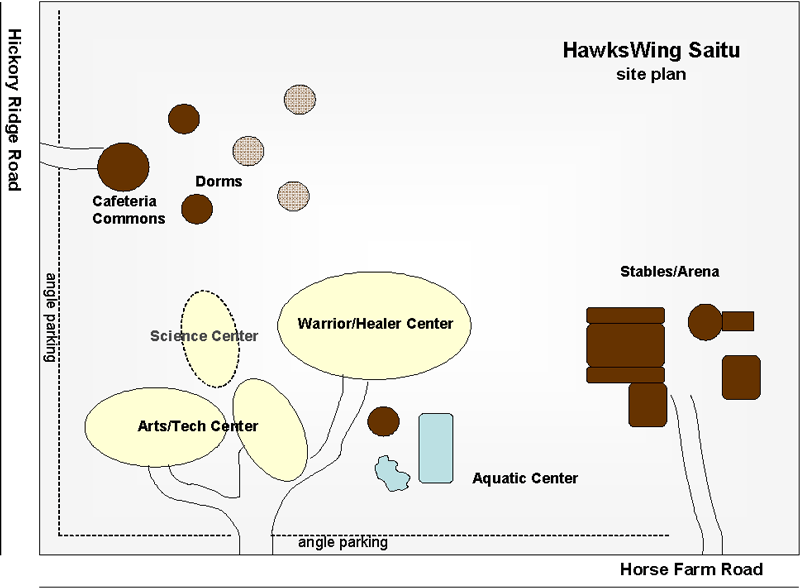
Hawk's Wing Saitu
| Background.
Many different cultures have encouraged the notion of developing warrior
and healing abilities as complements, with a focus on developing defense
and moral evaluative abilities for warrior needs. Most everyone
knows about the presence of such philosophies in Oriental cultures, but
it has also existed in places from the Nordsk to the natives of this
continent now called North America. According to some Amerindian
philosophies, a Saitu is a place
where people and others congregate to develop strengths of all sorts. Chanungkha, which can be translated roughly as "little or no person - mouth" from some Algonquian languages, is the name of the person that has gained quite a reputation for his abilities to assist others in healing and developing their own abilities. For another piece of jargon, the students are called "zaps" which is short for zapisurada. Zapisurada apparently translates roughly as "one who can heal you or kill you dead" from some Algonquian languages. This name is considered to be a not particularly gentle reminder to everyone about the sorts of capabilities that warriors and healers develop. Their warrior/healer philosophies of accepting payment only after and while significant improvements are occurring and keeping their remunerations within hundreds of dollars has helped these groups develop even greater reputations. Considering they almost always save people, with the more serious struggles, at least thousands of dollars over approaches deemed to be scientific by those that benefit most from these labels, the warrior/healer groups encourage those who have gained assistance to work to donate around 20% of what they save to some charities. This has also meant that quite an endowment has been developing for the establishment of other warrior/healer schools where healing is evident and substantive and often successful in contrast to those that claim to be scientific and expect money regardless of results. Though there are serious efforts to get developing warrior/healers to study approaches, particularly those labeled "scientific", that work in ways the warrior/healers have yet to equal. Chanungkha has been able to purchase a 25 acre old family farm, that used to have some horses to develop a state of the art Saitu. The plot of land is largely woods and open fields that have been farmed for generations on the downside of a fairly substantial ridge called Hickory Ridge. Most of the property is not directly accessible from the two roads that bound it on the south and west as shown in the following diagram. This is a general site plan of what should soon be developing. |

| Strong efforts are being made to keep all
motorized vehicles off the property. Though, the intent is to
be realistic for things like certain sorts of deliveries and client
interactions. There will be substantial angle parking on the
property at the perimeters abutting the roads. There is also a small two acre lake with a substantive stream running down through it on the property. Most of the areas further off the roads are intended to be used for things like trails and outdoor training and activities. Some farming will also be done on the site for a number of purposes. Chanungkha is actually quite the technophile and significant aspects of warrior/healer philosophies coordinate with developing "can-do", builder and "get things to work" mentalities. Their philosophies also enliven quests to find ever improving abilities to live and compete in technologically based cultures while striving to live in harmony with things such as ecosystems and others. So the intent is to have people that are involved with the Saitu have access to state of the art computing technologies in their quests. They intend to allow wireless access for the more rudimentary connections and data flows, but there are serious intentions to be doing sophisticated image and stream processing along with databases associated with healing and running businesses. For example, it is also intended that there be very substantive library sorts of reference materials online. So there are serious latency and security issues to be considered in backbone and access LAN designs. Now we will go through more details about specific aspects of the site, with some discussions about computing requirements, expectations and desires. You need to remember, this Saitu is looking to be prepared realistically for future eventualities and this is all new construction. Some of the overarching design strategies are to be
Warrior/Healer Center. The first building that will be constructed is going to be referred to as the Warrior/Healer Center until a better name comes along. The first diagram gives a side view. The length along the long axis of the ellipse is expected to be 80 feet. The length along the short axis is expected to be 40 feet. Though, the plans have yet to be finalized, this gives very reasonable and practicable estimates. It seems to only likely overall modifications will be to make the ellipses broader so that the shorter axis may be 50 or more feet. |
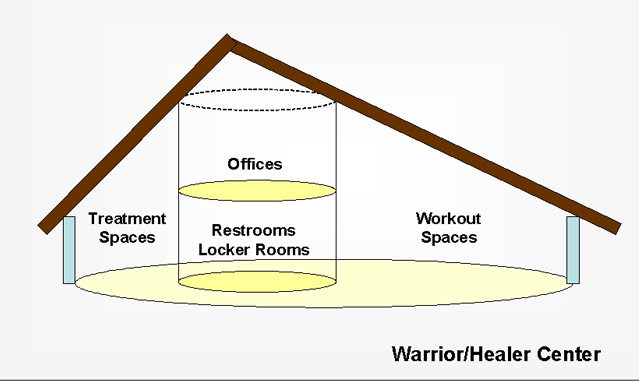
| Notice the offices are in the central core on the second floor. There will be windows out of these offices as well as things like rock climbing walls up the sides in some of the workout spaces. The following top view gives some more insight into the planned uses. There are also some plans to run a small hallway down the center of the treatment spaces to double the number of meeting/treatment rooms. |
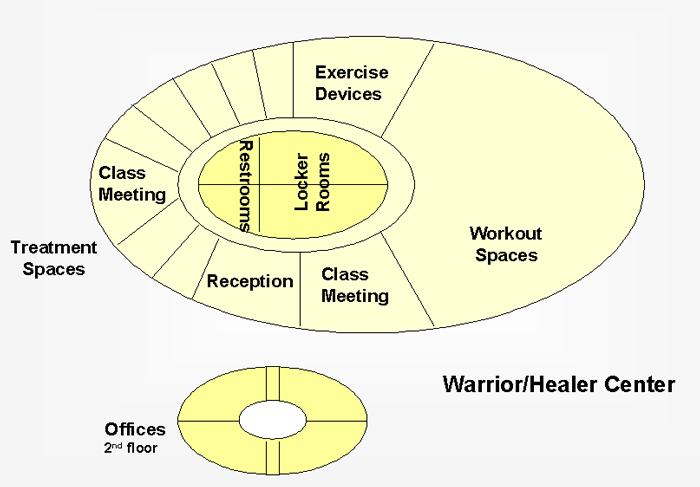
| More will be said. Arts/Tech Center. Hopefully it is not surprising that the next large building that will be built is an Arts/Tech Center. At present, and it seems likely to stay this way in the future, there are no intentions to make this Saitu a full service educational center to provide things like high school or college degrees. Though, there are efforts to allow attendees to gain course credits within these systems. But, there are serious needs for adolescents and older people to have spaces where they can gather and do things like develop their artistic spirit and abilities. There are also serious intentions to provide spaces for learning to work with metals. woods, electromechanical devices in addition to computers that aren't easily done within standard school systems. It should probably also be presently stated, that there are a considerable number of requests for both high school and college age students to find housing in this area to enjoy the offerings of the Saitu and enroll in degree programs at nearby educational institutions. Agreements for such options are already in place. These school systems seem to generally enjoy the influx of highly motivated young people getting involved with the Hawk's Wing Saitu. Each individual building in the Arts/Tech Center is not intended to have a footprint as large as the Warrior/Healer Center. The auditorium will probably only seat a few hundred. But it is intended to provide serious studio and instrumental practice facilities for those dedicated to developing such crafts. The lab space will house some common spaces for computers in addition to the site's data center. You should assume that second floor of each building will house four offices and the overall side view of each building will be analogous to that for the Warrior/Healer Center. The following gives a top view of the Arts/Tech Center. |
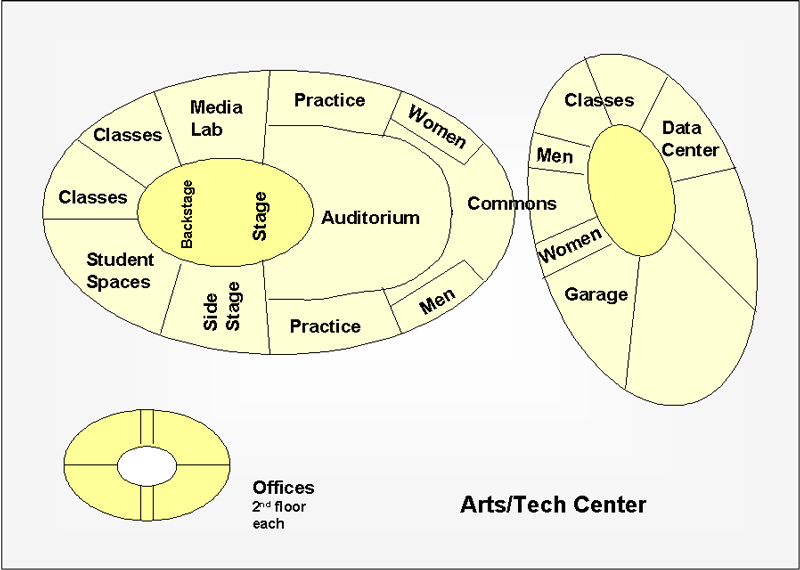
| You need to remember that most music composition
and much performance is done with computer electronics. The
Saitu will be quite state of the art in terms of these sorts of
capabilities. Most of the media arts are highly
technologically sophisticated. How much more these will be
developed is still an issue of some discussion. Notice the commons spaces and auditorium are expected to be highly adaptive in their uses. Wire ports need to be available, but wireless connectivity is clearly going to be the most adaptable. There is also some strong desire to include a science center in this cluster, so you want to include this even though it isn't in the drawings. It is likely to abut so that its commons area is adjacent to the other commons areas. The building will be multi-purpose but possibly as large as the tech center. There are plans to ensure that this building also has some sort of auditorium that is designed for many different purposes. It's likely that the saitu's acrobat troupes will practice and sometimes perform here and want plenty of space and equipment. The design needs to be highly adaptive. Most of the warrior/healer philosophies about development include things such as learning anatomy, physiology and other sciences as young "zaps" develop. The thinking is that if these things are learned as they go and constantly utilized the zaps will pick things up with much less effort than is required in schools. Fortunately, this has proven to be the case. For example, as young zaps learn even the most basic self defense maneuvers, they are also learning about major muscles, bones and some organs. The extent of their learning increases as they study more. The students also get the opportunities to learn about other species as they advance. It is also intended that certain percentages of motivated zaps will eventually go to other institutions to study what is usually called "scientific" approaches. While the validity of whether such "scientific" approaches are really very scientific is debatable, they still have a fair amount to contribute to assisting healing. For example, it is hoped by many that having some warrior/healers develop to be surgeons will help decrease the amount of intrusiveness and physical cutting that is used in these approaches. Aquatic Center. Hopefully, it isn't surprising that aquatic activity is very important in warrior/healer approaches. One of the main strategies used by warrior/healers is to supplement someone else's exertions. They typically aren't as challenging as what physical therapists sometimes have reputations for attempting, but working to assist healing in others while they are exerting in aquatic activities is very standard practice for reasons beyond this synopsis. Hot/cold therapies with the use of water, steam and dry heats are also quite important and pervasive. There is a desire to make these spaces quite comforting while being stimulating. Though the necessities for having extensive computing capabilities at this center is nowhere near as great as it is at other locations. Still, it seems important to prepare for future potentialities in the present new construction. The overall site plan for the Aquatic Center follows. |
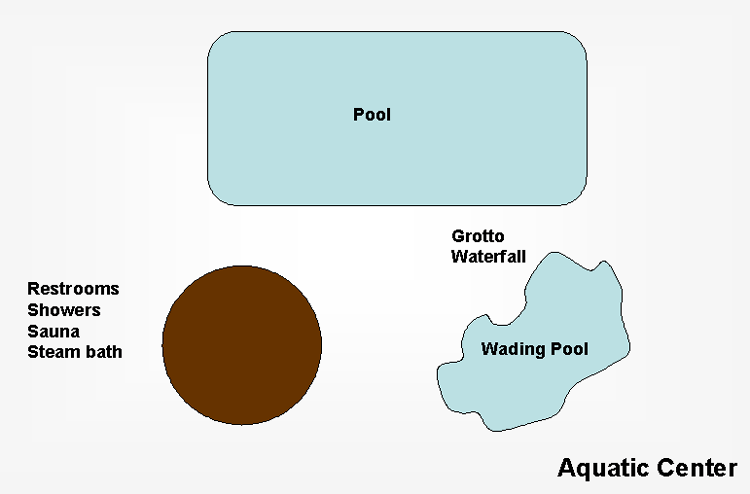
| While certain abilities to communicate and
interact with data sources are important for the staff. Almost
all clients will leave their electronics out of their water related
activities. Regardless, we give some quick diagrams for the planned Hot/Clean House. |
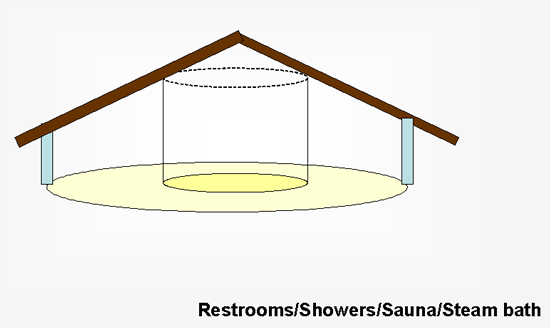
| The intent is to make sure there is sufficient
space and accessibility to allow clients to work with their healing
assistants in these spaces. The top view is generally more informative. |
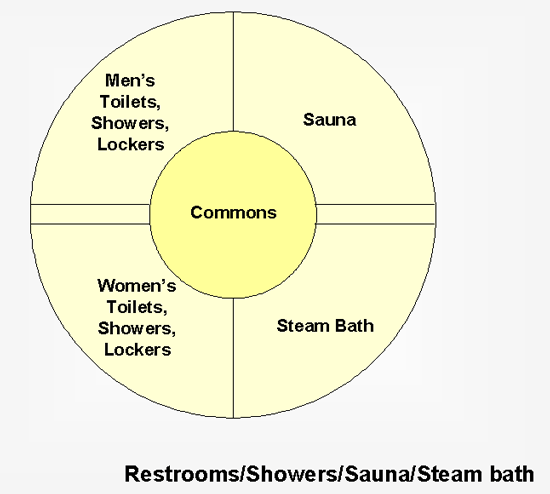
| The commons area is pretty much where
communication and computer capabilities need to be accessible.
Some though is being given to develop some office/treatment spaces
directly adjacent to the pool, but this is still open for
discussion. Such a building is very likely to be a
modification of the obvious patterns. Living Spaces. As we have mentioned, there is quite a bit of demand for dormitory space for high school and college aged people. Though, only certain things will be studied onsite. Some agreements have been reached in order to work with local schools. The plans for the cafeteria/commons have yet to reach a more developed stage. At present, only two dorms are about to start construction, though they anticipate adding three more in another year and several more the following. Since it is anticipated that most students will want to make use of the Internet and many of its capabilities, the desire is to allow for the following.
The dorms will be kept quite small. Each dorm will house people of the same gender. It appears the dorms could spread out fairly quickly. There is also a desire to leave sufficient open spaces for play and trails to link into larger trails on the property. A side view of a typical flattened teepee dorm is next. |
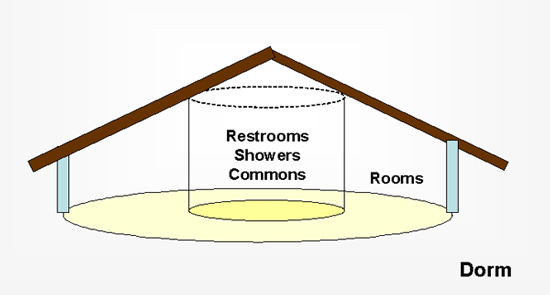
| A top view gives more information. |
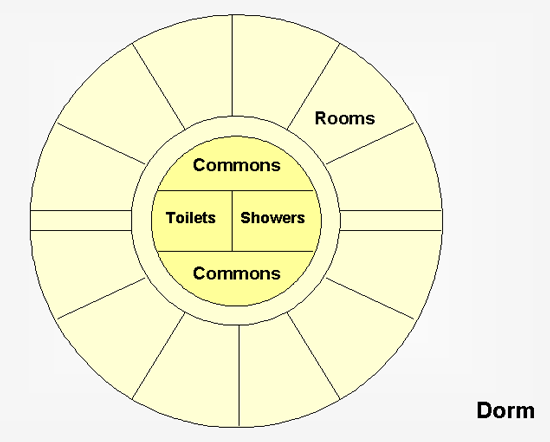
|
Stables/Arena. One of the
more surprising things for many people to
deal with is how Chanungkha is able to make
his spirit and that of animals apparent to
everyone present when he assists their
healing. Working with respect with
animals is a very important part of what
most students seek out at this Saitu. Without getting into too many details about specific operations and capabilities at present, we provide some plans for the stable/arena area. |
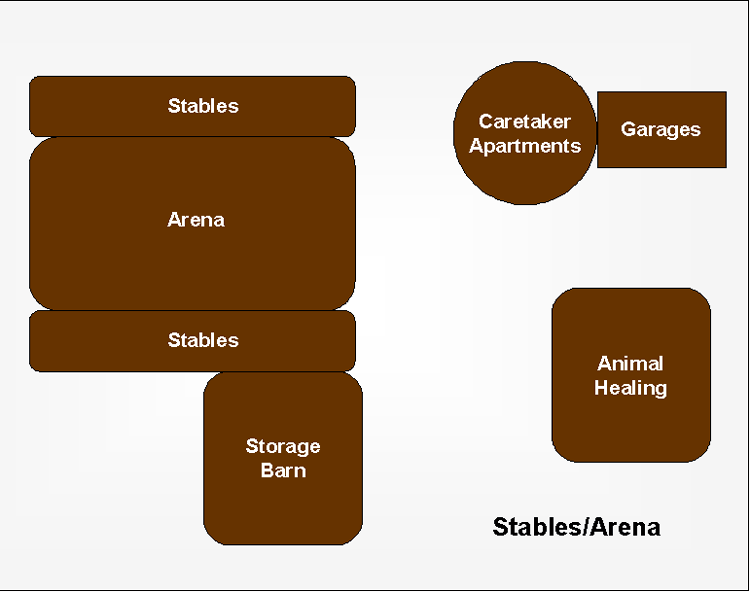
| There is also a desire to have
onsite help for working with the animals. It
is anticipated that college age students studying
Veterinary Technology or maybe even a couple interns
from Vet Schools will want onsite housing. Only the top down view is given for what is called the caretaker apartments. |
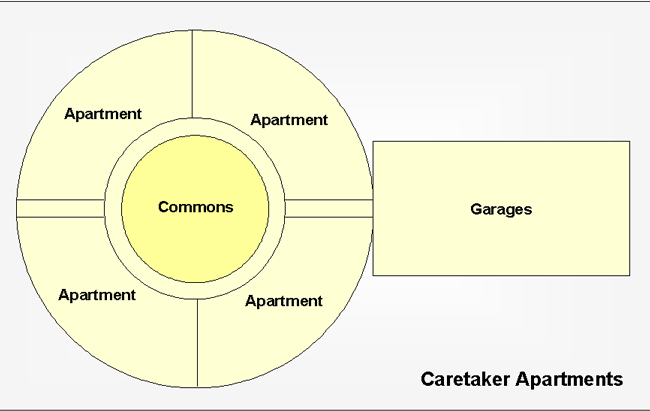
| Due to the fairly unique nature of what is developing and the growth and success that has already occurred, most of these buildings should be constructed within the next two years. |